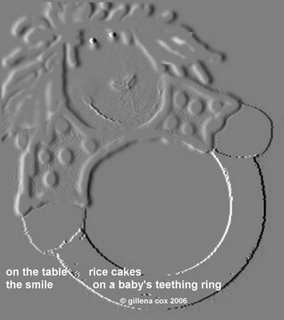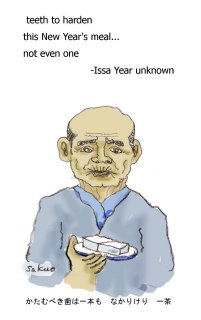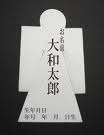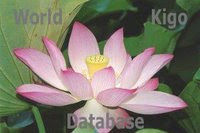:::::::::::::::::::::::::::::::::::::::::::::::::::::::::::::::::::::::::::::::::::::::::::::::::::::
Thunder (kaminari)
***** Location: Japan
***** Season: various, see below
***** Category: Heavens
*****************************
Explanation
lightning as kigo, see below.

source : us6.campaign-archive1.com
The usually fearsome God of Thunder has dropped his drum into the sea that makes a big thunder sound.
Thunder and lightning come together most often, but as kigo they are used in different seasons. Whilst
"thunder"by itself is a kigo for all summer,
"lightning" by itself is a kigo for all autumn.
The word kaminari seems to be derived from the meaning:
the gods are sounding, kami ga naru 神が鳴る.
Bill Higginson in his "Haiku World" suspects that the reason for this is the fact that in summer the farmers stayed inside during a thunderstorm, where they heard it only. In autumn during the harvest they were out and would also see it.
雷, if we look at the Chinese character for the word, means to have rain on the fields, so this is an expression for the deity that helps watering the rice paddies.
kami ... can also be interpreted as Kami san, the wife of the farmer, who wakes him up early in the morning and makes him work hard in the fields to feed the family. If she roars with her angry voice (kami ga naru), then the farmer had better work hard!
Let us look at some of the kigo used in Japan.
:::::::::::::::::::::::::::::::::::::::::::::::::::::::::::::::::::::::::::::::::::::::::::::::::::::
kigo for all spring
shunrai, spring thunder 春雷 thunder in spring
:::::::::::::::::::::::::::::::::::::::::::::::::::::::::::::::::::::::::::::::::::::::::::::::::::::
kigo for all summer
thunder, kaminari 雷, rai 雷, raiden 雷電,
..... kan nari かんなり, kamunari かむなり
In Japanese, the voice of this angry deity is represented as
GOROGORO ゴロゴロ.
ikazuchi いかずち,
voice of thunder, raimei 雷鳴
noisy gods, hatatagami はたた神、はたたく
gods are sounding, naru kami 鳴神
reverberation of thunder, raikyoo 雷響
thunderbolt, raitei, 雷霆
..... (the one which the Greek god Zeus used, later the Indian god Indra. In Japan it became known through Buddhism as a tool of the esoteric school, the thunderbolt of metal, kongosho 金剛杵) together with a bell representing the male and female element.
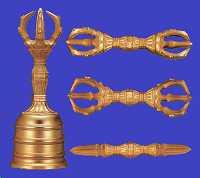
http://www.miyagawa.com/syuha/5103.html
thunder and rain, rai-u 雷雨 > Rainy Season (tsuyu)
thunder and flashes of light, raikoo 雷光 > inazuma below
flying thunder, jinrai 迅雷
thunder heard in the distance, enrai 遠雷
thunder out of the blue sky,
higaminari 日雷 (ひがみなり)
. . . . . but
日雷 【ひかみなり】 hikaminari, clear-sky thunder
quote from
http://etext.virginia.edu/japanese/haiku/saijiki/2su-2he.html
lightning striking the earth, rakurai 落雷
fire after a lightning stroke, raika 雷火
God of Thunder, raijin 雷神
drum of the God of Thunder、raiko 雷鼓
hatataku はたたく"noisy God"
..... (Look at my story about the Gods of the Elements).
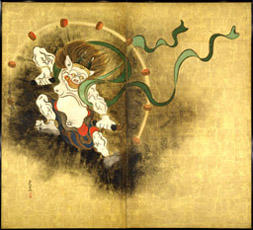
http://www.emuseum.jp/cgi/pkihon.cgi?SyoID=2&ID=w307&SubID=s000
.................................................................................
kigo for mid- summer
tsuyu kaminari 梅雨雷 (つゆかみなり)
thunder in the rainy season
..... tsuyu no rai 梅雨の雷(つゆのらい)
.................................................................................
observance kigo for late summer
kannarijin 雷鳴陣 (かんなりじん) "thunder army"
..... kannari no tsubo 雷鳴の壷(かんなりのつぼ)
..... rai no tsubo 雷の壷(らいのつぼ) "thunder jar"
At the time of Daigo Tenno, the imperial palace Seiryoden (seiryooden せいりょうでん【清涼殿】) once burned down after a lightning struck it and many courtiers died in the fire. After this, when in late summer a high-pitched thunder was heared three times, the army came out and had to shoot their arrows toward the sky in order to protect the court.
Thunder Jar was the name of the hall where the emperor had to hide during this ritual.
:::::::::::::::::::::::::::::::::::::::::::::::::::::::::::::::::::::::::::::::::::::::::::::::::::::
kigo for early autumn
aki no rai 秋の雷 (あきのらい) thunder in autumn
..... shuurai 秋雷(しゅうらい)
often together with lightning, inazuma, see below.
:::::::::::::::::::::::::::::::::::::::::::::::::::::::::::::::::::::::::::::::::::::::::::::::::::::
kigo for all winter
fuyu no rai 冬の雷 (ふゆのらい) thunder in winter
kanrai 寒雷(かんらい) thunder in the cold
yukigaminari 雪雷(ゆきがみなり)
snow and thunder
..... yuki no rai 雪の雷(ゆきのらい)snow and thunder
yuki okoshi 雪起し (ゆきおこし) "bringer of snow"
(waking up the snow)
buri okoshi 鰤起し ぶりおこし "bringer of yellowtail fish"
(waking up the yellowtail in winter)
:::::::::::::::::::::::::::::::::::::::::::::::::::::::::::::::::::::::::::::::::::::::::::::::::::::
Now let us look at lightning,
a kigo for all autumn.

The Japanese farmers of old believed that the lightning was needed to bring the rice plant to fully bear fruit.
lightning, inazuma 稲妻
... (lit. the wife of the rice plant)
いなずま is the correct hiragana, not いなづま
lord of lightning, ine no tono 稲の殿
lightening flash, inabikari 稲光
..... inatsurubi 稲交接 (いなつるび)
..... inatama 稲魂 (いなたま)
If lightning occurs in a different season, we have to mention this extra as
spring lightning, summer lightning, winter lightning.
...............................................................
Famous family crests with the lightning as subject.
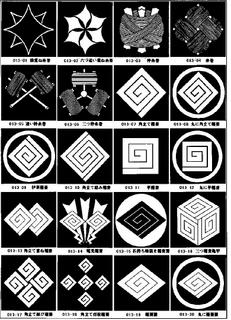
http://e-kamon.net/kamon013.html
*****************************
Worldwide use
Germany
Donner und Blitz.
Thor
by Micha F. Lindemans
Thor is the Norse Viking god of thunder. He is a son of Odin and Jord, and one of the most powerful gods. He is married to Sif, a fertility goddess. His mistress is the giantess Jarnsaxa ("iron cutlass"), and their sons are Magni and Modi and his daughter is Thrud. Thor is helped by Thialfi, his servant and the messenger of the gods.
Thor was usually portrayed as a large, powerful man with a red beard and eyes of lighting. Despite his ferocious appearance, he was very popular as the protector of both gods and humans against the forces of evil. He even surpassed his father Odin in popularity because, contrary to Odin, he did not require human sacrifices. In his temple at Uppsala he was shown standing with Odin at his right side. This temple was replaced by a Christian church in 1080.
The Norse believed that during a thunderstorm, Thor rode through the heavens on his chariot pulled by the goats Tanngrisni ("gap-tooth") and Tanngnost ("tooth grinder"). Lightning flashed whenever he threw his hammer Mjollnir. Thor wears the belt Megingjard which doubles his already considerable strength. His hall is Bilskirnir, which is located in the region Thrudheim ("place of might"). His greatest enemy is Jormungand, the Midgard Serpent. At the day of Ragnarok, Thor will kill this serpent but will die from its poison. His sons will inherit his hammer after his death.
Donar is his Teutonic equivalent, while the Romans see in him their god Jupiter. Thursday is named after him.
http://www.pantheon.org/articles/t/thor.html

http://www.viking-folklore.com/vikingstory-page/thor-god-of-thunder.html
:::::::::::::::::::::::::::::::::::::::::::::::::::::::::::::::::::::::::::::::::::::::::::::::::::::
North America
Thunderclap
A thunderclap is sudden loud thunder as a loud report similar to a canon shot.
It mostly comes unexpectedly more or less out of the blue and is quite startling.
It is close by and can make the air and ground shake.
I think "thunderclap" a candidate for kigo for late spring (western calendar) and early to mid summuer (lunar calendar).
This phenomenon certainly happens with frequency around this time of year especially if the weather is unseasonably hot and wet.
thunderclap -- the frizz* in our hair
*Human hair was/is used in humidity gages because as humidity increased the hair contracts making it an anolog computer for measuring humidity; also, in the case of the loud noise of a thunderclap, it may make ones hair standup from fright!
chibi (pen-name for Dennis M. Holmes)
:::::::::::::::::::::::::::::::::::::::::::::::::::::::::::::::::::::::::::::::::::::::::::::::::::::
Yemen
thunderheads, lightning and rumbling thunder
kigo for all summer
thunderheads --
a sorcerer plants amulets
at the borderline
~~~
rumbling thunder --
on-rushing waters
widen out their beds
~~~
lightning in gray skies
a silver ribbon - casting
Wadi Zabid
Heike Gewi
*****************************
Things found on the way

- CLICK for enlargement
流光 雷づくし Ryuko Kaminarizukushi
歌川国芳 Utagawa Kuniyoshi (1798-1861)
This print caricatures many Oni demons making various thunders, lightnings and showers.
quote
Yakusanoikazuchi 八雷神(やくさのいかづち)
Yakusa no ikazuchi no kami
The "eight kinds of thunder kami" that festered inside Izanami's corpse as seen by her consort Izanagi in the underworld of Yomi. Suffering mortal injury from giving birth to the fire kami Kagutsuchi, Izanami died and went to the underworld, where she was followed by Izanagi. Disobeying Izanami's warning not to look upon her, Izanagi lit a torch and saw her rotting body swollen and covered with maggots, and inhabited by the "eight thunder kami."
According to Kojiki, in her head was the "great thunder," in her breast was the "fire thunder," in her belly was the "black thunder," in her genitals was the "cleft thunder," in her left hand was the "young thunder," in the right hand was the "earth thunder," in her left leg was the "sounding thunder," and in her right leg was the "reposing thunder."
An "alternate writing" transmitted by Nihongi, however, states that "great thunder" was in her head, "fire thunder" was in her breast, "earth thunder" was in her belly, "young thunder" was in her back, "black thunder" was in her rectum, "mountain thunder" was in her hands, "field thunder" was in her feet, and "cleft thunder" was in her genitals. Of the eight thunders, three have the same name and place in the two accounts, three agree in name only, and the remaining two are different. The fact that eight thunders were produced in Izanami's dead body parallels the fact that eight kami were produced from the dismembered body of the fire kami Kagutsuchi. While eight is considered a sacred number, it is here likely used merely to denote "a great many."
According to the various Kojiki and Nihongi accounts mentioned above, Izanami ordered the "hags of Yomi" and the eight thunder kami to chase Izanagi, who had fled in horror after seeing the corrupted state of Izanami's body.
Izanagi, however, threw down magical peaches at Yomotsuhirasaka (the "Even Pass of Yomi"), and thus dispersed his pursuers.
source : Kobori Keiko, Kokugakuin, 2005
.................................................................................
八雷神社 Shrine of the Eight Thunder Deities
Yagusa Ikazuchi Jinja 八色雷神社(やぐさいかづちじんじゃ)
O-Ikazuchi 大雷(おほいかづち、イザナミの頭にある) head
Hono Ikazuchi 火雷(ほのいかづち、イザナミの胸にある) breast
Kuro Ikazuchi 黒雷(くろいかづち、イザナミの腹にある) stomach
Saku Ikazuchi 折雷(さくいかづち、イザナミの陰部にある) genitals
Waka Ikazuchi 若雷(わかいかづち、イザナミの左手にある) left hand
Tsuchi Ikazuchi 土雷(つちいかづち、イザナミの右手にある) right hand
Naru Ikazuchi 鳴雷(なるいかづち、イザナミの左足にある) left foot
Fusu Ikazuchi 伏雷(ふすいかづち、イザナミの右足にある) right foot

source : kue-biko
:::::::::::::::::::::::::::::::::::::::::::::::::::::::::::::::::::::::::::::::::::::::::::::::::::::
amulet from the shrine Shiba Daimyoojinguu 芝大神宮
Daimyojingu, Shiba Daimyojin Shrine
. chigibako 千木筥 / 千木箱 auspicious box .
..... Each box contains soy beans, so it sounds "karakara korokoro" when shaken.
The ladies used to hang this amulet from the beams of the kitchen. When a strong thunder rattled the home, they would eat some beans to appease the God of Thunder.
. kaminari and miminari 耳鳴り .
Temple Saifujkji 西福寺 at Kuwabara
kuwabara kuwabara is like a spell for lightning not to strike here.
*****************************
HAIKU
- - - - - Matsuo Basho and satori 悟り

source : tadaka/syoun-new 山田昭雲
稲妻にさとらぬ人の貴さよ
inazuma ni satoranu hito no tattosa yo
inazuma ni satoranu hito no tootosa yo
How admirable,
He who thinks not: Life is fleeting
When he sees the lightning!
Tr. Blyth
A virtuous monk once said:
"Superficial Zen is the root of grave flaws", and I appreciate his words.
lightning,
yet unenlightened:
so admirable
Tr. and comment by Barnhill
quote
A wise, virtuous priest said,
"half-baked zen leads to serious injuries."
I feel very grateful for his insight --
how inspiring,
those who have no satori
in a lightning flash
Basho placed a short note before the hokku. In his time many people were going around saying that after doing a little zen meditation they'd achieved very deep satori enlightenment in a single lightning-like flash, so an unnamed priest, presumably a zen master, spoke out in warning against superficial attempts to do and understand zen. The word I translated as "half-baked" could also be "half-assed, unripe, raw, incomplete, inexperienced."
It's not clear whether hito in the second line refers only to one person, i.e., the wise priest, or to all those impressive people, including the priest, who don't experience lightning-like satori and who don't indulge in hype and boasting. In my opinion Basho is praising all the pure-minded people, including the priest, who don't feel the need to promote themselves or see lightning-flashes after doing a bit of zen.
The same applies to writing haikai, of course.
- - - Tr. and comment by Chris Drake, translating haiku forum
Written in the autun of 1690, Genroku 3. 元禄3年秋
In a letter to Kyokusui 曲水宛書簡.
He complains about his light-hearted, but un-enlightened poetry disciples in Otsu 大津.
MORE hokku about tootoi, tattoi 尊─・貴─ by
. Matsuo Basho 松尾芭蕉 - Archives of the WKD .
Sitting silently, doing nothing
And the grass grows by itself.
Sitting quietly, doing nothing,
Spring comes,
and the grass grows, by itself.
attributed to Basho
(trying to find the Japanese)
深き山に 心の月し すみぬれば
鏡に四方の 悟りをぞ見る
fukaki yama ni kokoro no tsuki shi suminureba
kagami ni yomo no satori o zo miru
Deep within the mountains
the mind's moon
shines so bright.
It's light mirrors all things
like the enlightened mind.
. Saigyo Hoshi 西行法師 .
- quote
Satori (悟り)
is a Japanese Buddhist term for awakening, "comprehension; understanding". It is derived from the verb satoru.
In the Zen Buddhist tradition, satori refers to the experience of kenshō, "seeing into one's true nature". Ken means "seeing," shō means "nature" or "essence."
Satori and kenshō are commonly translated as enlightenment, a word that is also used to translate bodhi, prajna and buddhahood.
© More in the WIKIPEDIA !
芭蕉の禅修行 The Zen Training of Basho
- source : www.ne.jp/asahi/sindaijou/ohta
- Read: : The Haiku Apprentice - Haiku, Basho and Zen -
:::::::::::::::::::::::::::::::::::::::::::::::::::::::::::::::::::::::::::::::::::::::::::::::::::::::

source : facebook
raisama らいさま "Honorable Thunder Man"
栃木県那須町高久, Ibaragi, Nasu
:::::::::::::::::::::::::::::::::::::::::::::::::::::::::::::::::::::::::::::::::::::::::::::::::::::::
- - - - - Kobayashi Issa - - - - -
正直に入梅雷の一ッかな
shoojiki ni tsuyu kaminari no hitotsu kana
one roll of thunder
actually honest --
rainy season starts
Tr. Chris Drake
This hokku is from the sixth month (July) of 1820, when Issa was living in his hometown. The hokku refers back several weeks to the time when the early summer rainy season began, and it uses characters (入梅) for tsuyu in the second line that mean "entering the rainy season," a reference to the 135th day after the beginning of lunar spring, the formal first day of the rainy season. This calendar date was very important for farmers, since they needed to begin planting their rice paddies by then, even if no rain was falling. Usually the date fell on or around June 10 on the Gregorian calendar (in 2014 it falls on June 11), a date which was pretty accurate, since the average rainy season in contemporary Tokyo lasts from June 8 to July 21.
In the hokku, there is some thunder on this presumably warm, humid first day of the official rainy season, and most people in the village probably wish the clouds would stop simply making sounds and actually start raining on their rice paddies and dry fields. Issa expresses this anxious yearning in terms of whether the thunder is faithfully or honestly representing the rainy season or simply making fake noises, and he seems very happy that one roll of thunder on this day was honest and accompanied by actual rain. The rainy season seems to have truly begun, and the chances of a drought and a poor rice crop diminish, at least for the moment.
Another hokku, from the fifth month (June) of 1822, looks at a similar situation as a metaphor for human relations:
ima no yo ya tsuyu kaminari no damashi-ame
the world today --
false rain during
rainy season thunder
The rainy season has begun, and the thunder and dark clouds make people feel as if it must be raining, but when they look outside, nothing's falling. The way the thunder is accompanied only by illusory, trickster rain seems to remind Issa of the way many people in the increasingly commercialized rural society of his day use empty words and casually break promises.
Chris Drake
- - - - -
雷に焼かれし山よ秋の雨
kaminari ni yakareshi yama yo aki no ame
hey there, mountain
charred by lightning,
it's autumn rain
Tr. Chris Drake
This hokku is from the 8th month (September) of 1818, when Issa is living in his hometown and traveling around to towns near it. In it Issa directly addresses the blackened, lightning-struck mountain, as indicated by the exclamatory particle yo. He expresses his deep sympathy with the mountain and lets the mountain know he shares its happiness as a cool, steady rain falls on it. It seems possible Issa may also be trying to soothe the mountain by stressing that there is less danger of more lightning now that summer has ended.
Chris Drake
. Kobayashi Issa 小林一茶 in Edo .
:::::::::::::::::::::::::::::::::::::::::::::::::::::::::::::::::::::::::::::::::::::::::::::::::::::::
sleepless night -
man and mountain vibrate
in thunder
schlaflose Nacht -
Mensch und Berg erzittern
im Donner
Gabi Greve, June 2005
:::::::::::::::::::::::::::::::::::::::::::::::::::::::::::::::::::::::::::::::::::::::::::::::::::::::
inazuma ya kinoo wa higashi kyoo wa nishi
Enomoto Kikaku
"Summer Lightning"
Lightning-play --
that yesterday was in the east,
is in the west today.
Tr. and title by Harold Henderson
http://www.islandnet.com/~see/weather/arts/haiku_2.htm
.. .. ..
In Portugese
Trovão —
Ontem a leste,
Hoje a oeste.
From the Antologia de Haicais Clássicos
http://www.kakinet.com/caqui/antojapo.shtml
> Summer lightning!
> Yesterday in the East,
> Today in the West.
"The original does not say 'Summer' lightning, but actually in Japan summer is the season for lightning and storms generally."
Tr. Blyth
> flashes of lightning -
> yesterday in the east
> today in the west
Tr. Gabi Greve
:::::::::::::::::::::::::::::::::::::::::::::::::::::::::::::::::::::::::::::::::::::::::::::::::::::
Gewitterstimmung:
Blitze und Donner
fallen aus allen Wolken.
Ernst Ferstl
http://www.wegzumbuch.de/frame.htm?http://www.wegzumbuch.de/artikel10017.html
:::::::::::::::::::::::::::::::::::::::::::::::::::::::::::::::::::::::::::::::::::::::::::::::::::::
From the Shiki archives (8/31, 1997)
this second
before the thunder
all the lilies silver
paul m
distant thunder -
the carpenter
gathers his tools
doris k.
above the sunflowers
a lone thunderhead
edged in gold
Hilary Tann
Read a lot more haiku about THUNDER here:
http://shiki1.cc.ehime-u.ac.jp/~shiki/kukai/kukai19-1.html
:::::::::::::::::::::::::::::::::::::::::::::::::::::::::::::::::::::::::::::::::::::::::::::::::::::
in meditation -
the distant rolling thunder
echoes my restless mind
Mark Snyder (Fayetteville, NC)
WKD . Facebook
:::::::::::::::::::::::::::::::::::::::::::::::::::::::::::::::::::::::::::::::::::::::::::::::::::::
rain sings ---
thunder responds by beating
the drum of heaven
raju samal
India,August 2009
::::::::::::::::::::::::::::::::::::::::::::::::::::::::::::::::::::::::::::
:::::::::::::::::::::::::::::::::::::::::::::::::::::::::::::::::::::::::::::
..... Inazuma, Kigo for All Autumn
稲妻にけらけら笑ひ仏哉
inazuma ni kera-kera warai hotoke kana
in the lightning
how he laughs...
Buddha!
Issa
There are about 20 haiku about lightning by Issa,
translated by David Lanoue.
http://webusers.xula.edu/dlanoue/issa/search.html
:::::::::::::::::::::::::::::::::::::::::::::::::::::::::::::::::::::::::::::::::::::::::::::::::::::
- - - - - Matsuo Basho - - - - -
稲妻や闇の方行く五位の声
. inazuma ya yami no kata yuku goi no koe .
A lightning gleam:
into darkness travels
a night heron’s scream
Tr. ?
いなずまを手にとる闇の紙燭哉
inazuma o te ni toru yami no shisoku kana
Basho wrote this haiku in response to one of his disciples, Rika 李下, comparing his haiku to someone who holds a small torch lamp with a paper shade as if it were a bold of lightning.
a torch lamp
taken in the hand in the dark
(like a) bolt of lightning

These kinds of lamps were used in the Edo period.
Pine turpentine was used and a folded paper to shade the flame.
lightning
clenched in the hand:
torchlight in the dark
Tr. Barnhill
Ces éclairs, les prendre
à la main dans la nuit noire
en faire des torches
source : www.chichinpuipui.fr
. Matsuo Basho 松尾芭蕉 - Archives of the WKD .
:::::::::::::::::::::::::::::::::::::::::::::::::::::::::::::::::::::::::::::::::::::::::::::::::::::
- - - - - Yosa Buson - - - - -
稲妻にこぼるる音や竹 の露
inazuma ni koboruru oto ya take no tsuyu
A flash of lightening!
The sound of drops
Falling among the bamboo.
Tr. Takase
.. .. ..
稲妻や浪もてゆ(結)へる秋津しま
inazuma ya nami moteyueru akitsushima
lightning --
girdled by waves
islands of Japan
Tr. haikupoet.com
lightning -
the Islands of Japan
are surrounded by waves
Tr. Gabi Greve
Akitsushima, the "Islands of the Dragonflies" / Japan
雷に小家は焼かれて瓜の花
kaminari ni koya wa ya yakarete uri no hana
the thunderstorm
burned down the hut -
gourd blossoms
. WKD : uri no hana 瓜の花 gourd flowers, melon flowers .
. Yosa Buson 与謝蕪村 in Edo .
:::::::::::::::::::::::::::::::::::::::::::::::::::::::::::::::::::::::::::::::::::::::::::::::::::::
inazuma ya tarai no soko no wasure-mizu
lightning flash —
in the bottom of the basin,
water someone forgot to throw out
Masaoka Shiki
:::::::::::::::::::::::::::::::::::::::::::::::::::::::::::::::::::::::::::::::::::::::::::::::::::::
The Supreme Court also,
Paused for a while,
During the thunder claps.
Tousha, trans. Blyth
inazuma no ryokushuu o abu no no hate ni
a lightning flash
soaked in green glaze
far beyond the field
Kuroda Momoko, trans. Ueda
Compiled by Larry Bole
*****************************
Related words
***** .. .. .. .. RAIN in various kigo
***** .. .. .. WIND in various kigo
***** Monsoon
***** . WKD : uri 瓜 melons and gourds .
:::::::::::::::::::::::::::::::::::::::::::::::::::::::::::::::::::::::::::::::::::::::::::::::::::::
:::::::::::::::::::::::::::::::::::::::::::::::::::::::::::::::::::::::::::::::::::::::::::::::::::::
Windgott
(Fuuten, Fuujin; Vaayu: Trägt eine wehende Gebetsfahne in der Hand. Bart, Haare und Gewand flattern im Wind. Alte indische Gottheit, bringt Kindersegen, Glück und Reichtum. Nordwesten.
Windgott, Donnergott (Fuujin, Raijin)
Als Gefolge der Tausendarmigen Kannon. Wohl identisch mit dem bereits beschriebenen Wind- und Donnergott Fuuten und Raiten.
Eine volkstümliche Form sind die "Dämonen-Firstziegel" (onigawara), mit denen man sich der regenspendenden und feuerverhütenden Kraft der Gottheiten versichert.
Ikonografie:
Immer zwei dämonenhafte Gestalten. Oberkörper nackt, Unterkörper mit langem Hüfttuch oder Tigerlederschurz. Stehen in wallenden Wolken. Der eine hält einen großen Windsack hoch über dem Kopf, der andere Trommelschläger, auch "Donnerschläger" (raisho) genannt; um ihn herum befindet sich eine Reihe von kleinen Trommeln (renko), mit denen er den Donner schlägt.
. Buddhastatuen ... Who is Who
By Gabi Greve
:::::::::::::::::::::::::::::::::::::::::::::::::::::::::::::::::::::::::::::::::::::::::::::::::::::

source : rakuten.co.jp/omaturi
hanten 風神雷神 半纏 festival coat
:::::::::::::::::::::::::::::::::::::::::::::::::::::::::::::::::::::::::::::::::::::::::::::::::::::
. Gods of the Elements .
fuujin raijin 風神 雷神
[ . BACK to WORLDKIGO TOP . ]
[ . BACK to DARUMA MUSEUM TOP . ]
:::::::::::::::::::::::::::::::::::::::::::::::::::::::::::::::::::::::::::::::::::::::::::::::::::::

